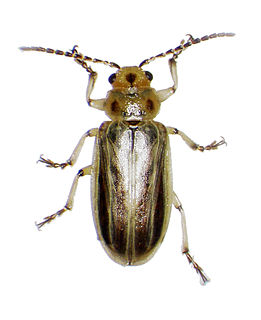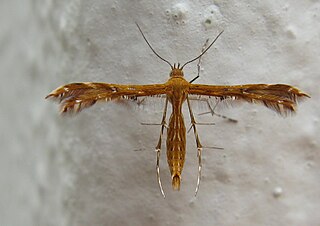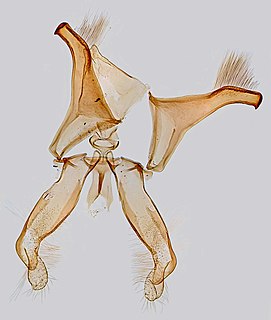
The genus Tamarix is composed of about 50–60 species of flowering plants in the family Tamaricaceae, native to drier areas of Eurasia and Africa. The generic name originated in Latin and may refer to the Tamaris River in Hispania Tarraconensis (Spain).

The Pterophoridae or plume moths are a family of Lepidoptera with unusually modified wings. Though they belong to the Apoditrysia like the larger moths and the butterflies, unlike these they are tiny and were formerly included among the assemblage called "microlepidoptera".

Pterophorus pentadactyla, commonly known as the white plume moth, is a moth in the family Pterophoridae. It is found in the West Palearctic including North Africa and Europe. The wingspan is 26–34 mm (1.0–1.3 in). It is uniformly white, with the hind wing pair divided in three feathery plumes and the front pair in another two. The moths fly from June to August. The larvae feed on bindweed.

Zygaena trifolii, the five-spot burnet, is a moth in the family Zygaenidae. It is found from North Africa, through the western Mediterranean, Great Britain and central Europe to Ukraine. It is not found in Scandinavia.

Diorhabda carinulata is a species of leaf beetle known as the northern tamarisk beetle, which feeds on tamarisk trees from southern Russia and Iran to Mongolia and western China. This beetle is used in North America as a biological pest control agent against saltcedar or tamarisk, an invasive species in arid and semiarid ecosystems.

Tamarix gallica, the French tamarisk, is a deciduous, herbaceous, twiggy shrub or small tree reaching up to about 5 meters high.

Diorhabda carinata is a species of leaf beetle known as the larger tamarisk beetle which feeds on tamarisk trees from Ukraine, eastern Turkey and Syria east to northwest China, Kyrgyzstan and Pakistan, extending as far south as southern Iran. It is used in North America as a biological pest control agent against saltcedar or tamarisk, an invasive species in arid and semi-arid ecosystems.

Diorhabda sublineata is a leaf beetle known as the subtropical tamarisk beetle (STB). The species was first described by Hippolyte Lucas in 1849. It feeds on tamarisk trees from Portugal, Spain and France to Morocco, Senegal, Algeria, Tunisia, Egypt, Yemen, and Iraq. It is used in North America as a biological pest control agent against saltcedar or tamarisk, an invasive species in arid and semi-arid ecosystems.

Muschampia flocciferus, the tufted skipper or tufted marbled skipper, is a butterfly of the family Hesperiidae.

Hellinsia osteodactyla is a moth of the family Pterophoridae. It is found in most of Europe, as well as North Africa and from Asia Minor to Japan. Also known as the small golden-rod plume it was first described by Philipp Christoph Zeller in 1841.

Platyptilia isodactylus is a moth of the family Pterophoridae found in China, Europe and was introduced to Australia for biological control. It was first described by the German entomologists, Philipp Christoph Zeller in 1852.

Hellinsia lienigianus is a moth of the family Pterophoridae which inhabits coastal areas, dry pastures and waste ground and is found in Africa, Asia, Australia and Europe. Also known as the mugwort plume it was first described by Philipp Christoph Zeller in 1852.

Agdistis meridionalis, the sea-side plume, is a moth of the family Pterophoridae, first described by the German entomologist Philipp Christoph Zeller in 1847. It is found in Europe.

Platyptilia farfarellus is a moth of the family Pterophoridae. The species was described by Philipp Christoph Zeller in 1867. It is found from central and southern Europe to Asia Minor, Micronesia and Japan. It is also known from Africa, where it has been recorded from Equatorial Guinea, Kenya, Madagascar, Mauritius, Nigeria, South Africa, São Tomé & Principe, Tanzania, Uganda, the Seychelles and Malawi.

Stenodacma wahlbergi is a moth of the family Pterophoridae described by Philipp Christoph Zeller in 1851. It is known from Japan, China, Saudi Arabia, Iran, Sri Lanka, India, Central, East and South Africa, St. Helena, Mauritius, the Seychelles and Rodriguez Island. It has recently been recorded from Vietnam. Records for Australia were based on synonymisation with Stenodacma pyrrhodes.

Agdistis bennetii is a moth of the family Pterophoridae found in Europe. It inhabits salt marshes.

Crombrugghia distans, also known as the Breckland plume is a moth of the family Pterophoridae found in Africa, Asia and Europe. It was first described by Philipp Christoph Zeller in 1847.

Crombrugghia laetus, also known as the scarce light plume is a moth of the family Pterophoridae, found in southern Europe, North Africa, the Canary Islands, Asia Minor and Iraq. It was first described by Philipp Christoph Zeller in 1847.
Agdistis frankeniae is a moth in the family Pterophoridae. It is found from Siberia through Central Asia, the northern parts of Asia and North Africa along the Mediterranean and in the west from the Canary Islands to southern France.
Coleophora vibicigerella is a moth of the family Coleophoridae found in Asia, Europe and north Africa. It was first described by Philipp Christoph Zeller in 1839.
















